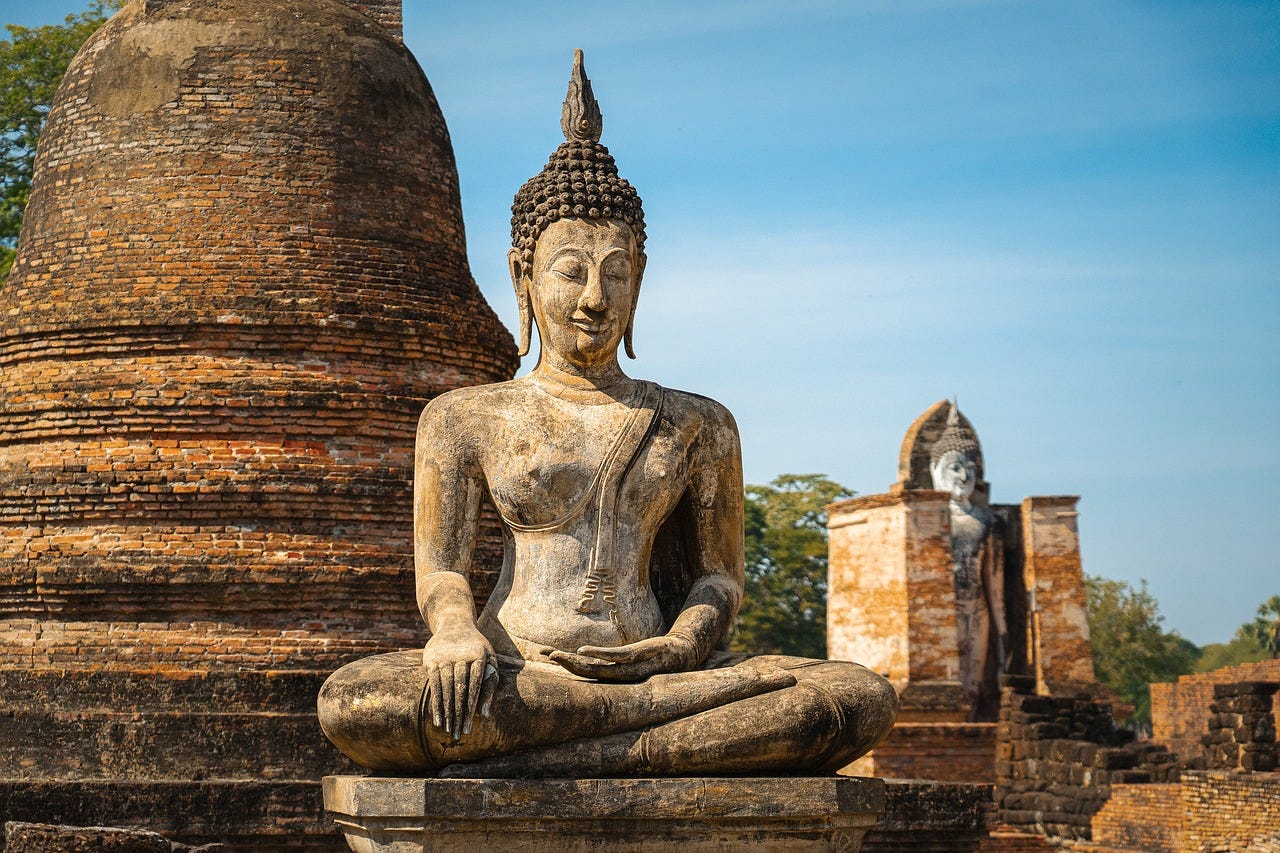Aristotle And Buddhism On Seeking Balance
The dangers of black and white thinking, and how to avoid them
Hi there,
In today’s post I discuss black and white thinking. I explore why we do it, problems it can cause, and how to find a more balanced approach.
Okay, let’s get straight to today’s article.
Benefits Of Black And White Thinking
In sixth grade, my daughter announced that Math was her favorite subject. I was a little surprised and asked her why. She told me it’s because there’s always one right answer.
My daughter was discovering how most things in the world are not black and white. She was coming to terms with this and missing the simplicity of her younger self.
This is a normal part of development. Small kids see the world in extremes. Right and wrong. Good and bad. Our schooling leads us to think in this way. And there are some good reasons why.
We teach our kids about the world through setting problems:
What is 7 x 8?
Who was the first president of the United States?
Is “jump” a noun or a verb?
All these questions have one correct answer. These kinds of problems help children learn the rules of Math, History, or Grammar.
There’s nothing wrong with either/or thinking… when the question has an either/or answer. Unfortunately, most real-life situations don’t have a single correct response.
When Black and White Thinking Fails
Imagine you’re watching two preschoolers, and they are fighting over a toy car. There are plenty of other cars, but this one is the biggest and the fastest. They both want the same toy, and they aren’t backing down.
In this scenario black and white thinking doesn’t work. It isn’t fair to give the toy to one kid and not the other. You need to find a solution where both kids benefit equally. Instead of giving the toy to one, you find a way for them to share.
Any parent or carer has navigated this situation many times. It’s how we help children develop social skills. But sharing isn’t only about discovering how to be kind or ethical. It’s also about learning how to apply ‘both/and’ thinking.
We’re all prone to either/or thinking. One pernicious way we do this is by labelling individuals as good or bad. We even do it to ourselves. We swing between the extremes of thinking the best or worst. But nobody is wholly “good” or “bad”.
Another example of black and white thinking is viewing our efforts in terms of success or failure. This view of the world assumes there are only two outcomes: success (good) or failure (bad). Such thinking can be severely limiting.
I often see this with coaching clients who are paralyzed by fear of failure. No matter how much they want to change, they feel stuck. All or nothing thinking holds them hostage. They overlook all the possibilities that lie between the extremes of success and failure.
I’ve already discussed how early education encourages us to think in terms of right and wrong. There’s another reason why we fall victim to black and white thinking. Narrow focus was once a key survival tool. It offered early humans an evolutionary advantage, by helping them avoid predators or seek prey.
“natural selection didn’t design your mind to see the world clearly; it designed your mind to have perceptions and beliefs that would help take care of your genes.”
― Robert Wright, Why Buddhism is True
Unfortunately, what once benefited humankind can also have a detrimental effect on our relationships, careers, and health. It can even make us vulnerable to cults, perfectionism, and mood swings. In extreme cases, dichotomous thinking correlates with certain disorders, including: narcissism, eating disorders, and the Dark Triad traits.
The Wisdom Of Aristotle and Buddhism
This is not a new phenomenon. For millennia, wisdom teachers have cautioned against the extremes. In his Nicomachean Ethics, Aristotle introduced the “golden mean” principle. This is the idea that every virtue is a balance between two polarities.
For example, courage lies between cowardice and recklessness. A deficiency of courage results in fearfulness, whereas an excess gives rise to foolhardiness. Similarly, confidence falls between self-deprecation and arrogance. While generosity lies between stinginess and profligacy.
The Buddha also warned against excess and deficiency. He told his followers to seek the middle path which exists between self-denial and sensual indulgence.

We don’t want to deny ourselves the joy of aliveness, nor do we want to become victims of our desires. The Middle Way avoids the pitfalls of these two extremes.
“The middle way is a view of life that avoids the extreme of misguided grasping born of believing there is something we can find, or buy, or cling to that will not change. And it avoids the despair and nihilism born from the mistaken belief that nothing matters, that all is meaningless.”
- Sharon Salzberg
The good news is that you already know how to avoid black and white thinking. Remember, the sharing example from the beginning of this post? Both/and thinking (as opposed to either/or) is just like sharing a toy car.
Flip-Flopping and Zooming Out
An easy mistake to make when seeking the middle path is flip-flopping between extremes. Perhaps, you realize the error in your ways and react by swinging to the opposite pole. I see this in my own life. For example, when I’ve been careless with someone’s feelings (especially if it’s one of my kids) and I overcompensate when making it up to them.
I also do this with new projects. I can fluctuate between pouring my energy into an effort and doing nothing. Neither of these two extremes is healthy. Understanding this tendency is the first step towards correcting it. (Forming new habits is the next step – I’ll talk more about this in a future post).
According to Barry Johnson, author of Polarity Management, our preference for one extreme or another arises from a combination of our values and fears. Someone prefers one pole over another because they value the upside of their preferred pole and/or they fear the downside of the opposite pole.
When you’re stuck in an extreme, you’re being driven by your unconscious. A shift in your fears and desires can cause a sudden swing in one direction. You’re flip-flopping and yet you aren’t aware you’re doing it.
To avoid flip-flopping or remaining stuck look for the pros and cons of both sides. Then consider how you might balance the two. Try asking yourself:
How can I experience the benefits of both [pole X] and [pole Y], while minimizing their downsides?
This involves widening your lens so that you’re not just viewing the benefits of one extreme and/or the downsides of the opposite. It requires a willingness to see multiple perspectives. I call this “zooming out”.

Here are some practices to help you practice zooming out:
Listen to diverse viewpoints. This can be on social, political, or personal topics. Actively seek out and understand the opposite viewpoint to your current one.
Love your enemy. When you’re in conflict with someone, put yourself in their shoes. Try to understand why they are behaving as they are. You may not agree with their words or actions, but can you see what is motivating them?
Embrace uncertainty. Instead of fearing it, view uncertainty as an opportunity for growth and learning. Uncertainty can feel unsafe and so be gentle with yourself. Meditation can help here.
Take an academic class or join a debate group. In January, I started a second degree and it’s been helpful for developing my critical thinking. In higher education, you’re required to consider all sides of an argument. Similarly, a debate group may ask you to take the opposite view to the one you already hold.
Growth happens when you can balance multiple perspectives without falling prey to either/or thinking. This skill also frees you from the pull of external forces and the risk of becoming fixated on a single viewpoint.
Best of all, zooming out opens a path to greater ease, confidence, and meaning.


